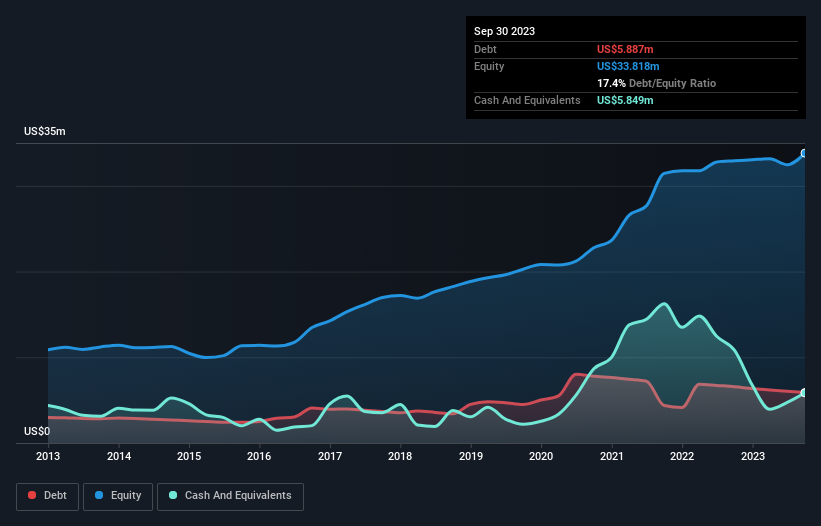- United States
- /
- Basic Materials
- /
- NasdaqCM:SMID
Smith-Midland (NASDAQ:SMID) Takes On Some Risk With Its Use Of Debt
Howard Marks put it nicely when he said that, rather than worrying about share price volatility, 'The possibility of permanent loss is the risk I worry about... and every practical investor I know worries about.' So it seems the smart money knows that debt - which is usually involved in bankruptcies - is a very important factor, when you assess how risky a company is. We note that Smith-Midland Corporation (NASDAQ:SMID) does have debt on its balance sheet. But the more important question is: how much risk is that debt creating?
What Risk Does Debt Bring?
Debt and other liabilities become risky for a business when it cannot easily fulfill those obligations, either with free cash flow or by raising capital at an attractive price. In the worst case scenario, a company can go bankrupt if it cannot pay its creditors. However, a more usual (but still expensive) situation is where a company must dilute shareholders at a cheap share price simply to get debt under control. By replacing dilution, though, debt can be an extremely good tool for businesses that need capital to invest in growth at high rates of return. When we think about a company's use of debt, we first look at cash and debt together.
Check out our latest analysis for Smith-Midland
How Much Debt Does Smith-Midland Carry?
The image below, which you can click on for greater detail, shows that Smith-Midland had debt of US$5.89m at the end of September 2023, a reduction from US$6.57m over a year. On the flip side, it has US$5.85m in cash leading to net debt of about US$38.0k.

A Look At Smith-Midland's Liabilities
Zooming in on the latest balance sheet data, we can see that Smith-Midland had liabilities of US$12.9m due within 12 months and liabilities of US$10.9m due beyond that. On the other hand, it had cash of US$5.85m and US$18.6m worth of receivables due within a year. So it can boast US$575.0k more liquid assets than total liabilities.
Having regard to Smith-Midland's size, it seems that its liquid assets are well balanced with its total liabilities. So while it's hard to imagine that the US$127.6m company is struggling for cash, we still think it's worth monitoring its balance sheet. Carrying virtually no net debt, Smith-Midland has a very light debt load indeed.
Importantly, Smith-Midland's EBIT fell a jaw-dropping 33% in the last twelve months. If that decline continues then paying off debt will be harder than selling foie gras at a vegan convention. The balance sheet is clearly the area to focus on when you are analysing debt. But you can't view debt in total isolation; since Smith-Midland will need earnings to service that debt. So when considering debt, it's definitely worth looking at the earnings trend. Click here for an interactive snapshot.
But our final consideration is also important, because a company cannot pay debt with paper profits; it needs cold hard cash. So we clearly need to look at whether that EBIT is leading to corresponding free cash flow. Over the last three years, Smith-Midland saw substantial negative free cash flow, in total. While that may be a result of expenditure for growth, it does make the debt far more risky.
Our View
On the face of it, Smith-Midland's conversion of EBIT to free cash flow left us tentative about the stock, and its EBIT growth rate was no more enticing than the one empty restaurant on the busiest night of the year. But at least it's pretty decent at managing its debt, based on its EBITDA,; that's encouraging. Once we consider all the factors above, together, it seems to us that Smith-Midland's debt is making it a bit risky. Some people like that sort of risk, but we're mindful of the potential pitfalls, so we'd probably prefer it carry less debt. When analysing debt levels, the balance sheet is the obvious place to start. However, not all investment risk resides within the balance sheet - far from it. For example, we've discovered 2 warning signs for Smith-Midland that you should be aware of before investing here.
Of course, if you're the type of investor who prefers buying stocks without the burden of debt, then don't hesitate to discover our exclusive list of net cash growth stocks, today.
New: Manage All Your Stock Portfolios in One Place
We've created the ultimate portfolio companion for stock investors, and it's free.
• Connect an unlimited number of Portfolios and see your total in one currency
• Be alerted to new Warning Signs or Risks via email or mobile
• Track the Fair Value of your stocks
Have feedback on this article? Concerned about the content? Get in touch with us directly. Alternatively, email editorial-team (at) simplywallst.com.
This article by Simply Wall St is general in nature. We provide commentary based on historical data and analyst forecasts only using an unbiased methodology and our articles are not intended to be financial advice. It does not constitute a recommendation to buy or sell any stock, and does not take account of your objectives, or your financial situation. We aim to bring you long-term focused analysis driven by fundamental data. Note that our analysis may not factor in the latest price-sensitive company announcements or qualitative material. Simply Wall St has no position in any stocks mentioned.
About NasdaqCM:SMID
Smith-Midland
Smith-Midland Corporation invents, develops, manufactures, markets, leases, licenses, sells, and installs various precast concrete products and systems.
Outstanding track record with flawless balance sheet.
Market Insights
Community Narratives



